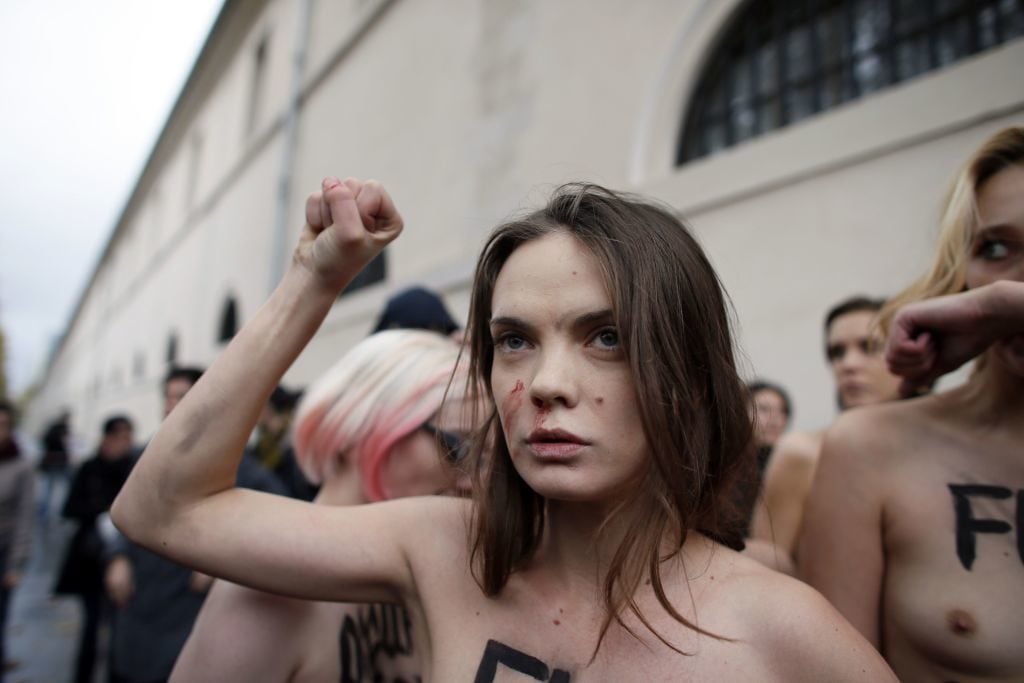People
‘Oksana Shachko Invented a Grammar of Activism’: How the Co-Founder of FEMEN Used Art as a Powerful Feminist Statement
In recent years Shachko was working as a full-time artist painting transgressive religious icons.

In recent years Shachko was working as a full-time artist painting transgressive religious icons.

Naomi Rea

The feminist artist Oksana Shachko, a founding member of the protest group FEMEN, has died at age 31. According to friends, the Ukraine-born activist, who had political asylum in France, left a suicide note in her Paris apartment.
Shachko was an artist from a young age. Educated in the Orthodox tradition, she made religious paintings and at the age of 8 her artistic talent earned her a place at a specialized school in Ukraine focused on painting religious icons. By age 10, Shachko was being commissioned to create church frescoes, and moved into the church full time at aged 12. As an adult, her later works subverted traditional religious iconography to create feminist art.
As she grew Shachko became disillusioned with religion. She recalled how aged 14, she had rejected her Orthodox education. “I understood that religion is just a fucking business and a tool to manipulate society. That made me very angry and I stopped painting the icons,” she told Crash magazine in November 2017.
Following this revelation, Shachko turned towards political activism, first as young Communist who wanted to clean statues of Lenin, she told Crash, and then as a firebrand feminist, eventually founding FEMEN with three others in 2008 in response to the unjust deaths of four women at a hospital in Khmelnitsky. Art remained central to her activism. Similar to the Russian punk protest group Pussy Riot, FEMEN is known for its activist protests disrupting political events, particularly for its topless protests directed at leaders they view as dictators or oppressors.
Shachko was responsible for the creative side of FEMEN’s public image, which captured the media’s attention—although at great risk to its members.
According to the group, in 2011 she was among three members seized by security officers following a topless protest mocking Belarusian President Alyaksandr Lukashenka. The women were taken to a forest and made to strip naked, their hair was cut off, and they were covered in oil and threatened with being set on fire. In 2013, she was also among those who confronted Vladimir Putin and German chancellor Angela Merkel in Hannover, Germany.
Shachko had been exiled in France since 2013, and after a dispute with fellow member Inna Shevchenko, left the movement in 2014 and returned to a career as a full-time artist. She enrolled in Paris’s Beaux-Arts school in 2017. One of her tutors, Olivier Blanckart, told the French newspaper La Croix that she initially saw the FEMEN action as an art performance. “The crown in her hair, painting on a bare bust: Oksana Chatchko invented an aesthetic grammar of activism,” Blankart said.
Her recent artwork drew from her experience painting religious icons as well as her time as a political activist. A series, “Iconoclast,” uses the traditional painting methods of Orthodox icons but subverts the traditional imagery by, for example, adding more women, such as four naked brides in place of the Knights of the Apocalypse, depicting saints wielding Kalashnikovs, or the crucifixion as an orgy.
She had her first solo exhibition in France at Galerie Mansart in 2016, exhibiting a series of seven religious “icons” referencing the seven Capital sins. In July 2016, she showed two icons in Espace Usanii in a show titled “Who’s That Girl?” Her latest exhibition was in Paris in June, when she showed some of her icons alongside work by Adel Abdessemed and Joseph Beuys in an exhibition titled “Talking About a Revolution!” at Galerie 22 Visconti, a space dedicated to the May 1968 protest movement.
A post on FEMEN’s website on July 23 mourned the the young artist’s death. “RIP. The most fearless and vulnerable Oksana Shachko has left us,” it read. “We mourn together with her relatives and friends.”
French authorities have since confirmed her death but are awaiting the results of an autopsy to confirm the cause.